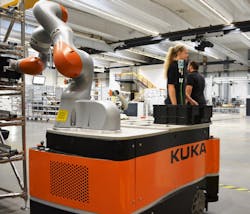KUKA Makes the Digital Transformation
Stop me if this sounds familiar: A successful, global manufacturing company operates using disconnected data drives, different product lifecycle management (PLM) and product data management (PDM) systems, and sometimes runs production out of its enterprise resource planning (ERP) system. In this disconnected systems scenario, collaboration and reuse of data is difficult and inefficient.
If we were talking face to face, you probably would have stopped me before I finished the first sentence. After all, not only is this situation common among global manufacturing companies, it’s common at most small- and mid-sized companies too. And this is where KUKA found itself in 2013, according to Greg LaMay, director of global PLM implementation at KUKA North America.
During a presentation at the Manufacturing in America 2018 event in Detroit, sponsored by Siemens and Electro-Matic, LaMay explained that the lack of digital connectivity at KUKA in 2013 meant that communication—from the proposal stage to process planning to factory simulation to mechanical design of systems layout—was only possible through email, PowerPoint presentations, discussions, shared drive access, etc. Only mechanical design and controls had access to the PLM system that stored all the data needed for each stage of the company’s operations. “Each department had no visibility into what the other was doing,” he said.
Recognizing the need to digitize, and connect its people and processes to better address market needs, KUKA implemented Siemens Teamcenter PLM to connect everyone from proposal to mechanical design. Having that level of connectivity “gives purchasing the ability to look at the data used by manufacturing process planners,” LaMay noted. He added that this degree of insight is critical because “procurement is the link between all our other processes and the actual manufacturing process. Teamcenter gives us a single source of the truth to do this.”
In an interesting twist to KUKA's digitalization story, LaMay said that to effectively address the company’s data disconnects with Teamcenter, KUKA began its transformation process with its marketing department. This process started by working with Siemens “using their Business Process Assessments across our global locations,” LaMay said. “This assessment, which is required before Teamcenter implementation, scores 40 areas for digital maturity and potential for optimization.”
Explaining the key to starting this process with marketing, LaMay said it is important to realize that, in any company, “change is unnatural, especially in a company that is doing well. So we had to sell [the need for a wide-ranging digital transformation] to the team that we had to make these changes to stay on top.”
Based on KUKA's digital transformation experience, LaMay shared the five key components to digitalization:
- Start with marketing. This department is key to building the relationships with organizational leadership and across the organization to make the change happen.
- Develop new operational processes around the new technologies to optimize efficiency in each department.
- As part of organizational change management, new business processes will have to be developed to correspond with the inevitable operational changes. LaMay said that, though “change is pain, it’s important to realize that new technologies will bring new efficiencies which should drive new business processes.”
- Training. This might sound obvious, but it is a critical aspect to ensuring that everyone fully understands the new technology and how to use it, as well as the company’s expectations of how it should be used.
- Provide face-to-face, ongoing training and support for the technology on the production lines. “Classroom training on its own is not enough,” LaMay said.
Another interesting insight LaMay pointed out about KUKA's digital transformation around Teamcenter PLM is the need to focus on production operations as much as, if not more than engineering. On projects like these, “everyone tends to focus on the engineers, but the bulk of people using the software are in manufacturing operations. For example, in a typical 1,000-person manufacturing company, 300-400 will be engineers; the rest will be in production operations. Operations is where even the smallest changes can add up to the biggest benefits.”
At the Manufacturing in America event, Raj Batra, president of the Digital Factory division of Siemens USA, highlighted how companies like KUKA are part of a growing trend toward digitalization and investment in the future of manufacturing. Noting recent investment announcements in U.S. manufacturing, Batra mentioned Boeing’s investment of $100 million to create the “workplace of the future” in the U.S.; Apple’s $30 billion investment that is expected to create 20,000 jobs here; Fiat Chrysler’s $1 billion investment for a Warren, Mich., plant, which is expected to create 2,500 jobs; ABInBev’s $2 billion investment in its U.S. plants; BMW’s $600 million investment in its Spartanburg, S.C. plant, which is expected to create 1,000 jobs; and Exxon Mobil’s $35 billion U.S. investment on top of the $15 billion it had previously announced.
“These are not brownfield upgrades,” Batra said, “but strategic new investments. Manufacturing is increasingly seen as a core competency for the U.S.—not something for outsourcing.”
He also pointed out that the digitalization trend is not something that benefits only newer companies. “Embracing the digital transformation benefits incumbents as well,” Batra said. “While digital native companies like Uber and Airbnb are growing fast (36 percent revenue growth) these companies are more subject to disruption. Incumbents embracing digital, however, are not as subject to disruption and are pulling away from the pack of incumbent companies that are not making the move toward digitalization.” Batra noted that incumbent companies making the digital transformation have experienced a 10 percent growth in revenues compared with their non-digital competitors that have seen just a 5 percent growth in revenues.
About the Author
David Greenfield, editor in chief
Editor in Chief

Leaders relevant to this article:
